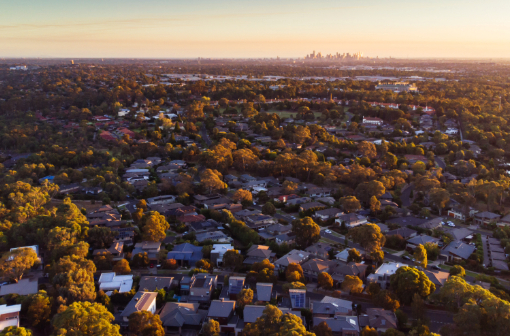“Green space is really important for people's psychological health … There's a lot of research about the value of green space in terms of helping us to relax and recharge in an environment that's not overstimulating.”—Professor Susan Thompson, UNSW’s Built Environment.
Key points
- The Australian Unity Wellbeing Index has found that where we choose to live can make a tangible difference to our quality of life, with those living in rural and regional areas tending to be happiest.
- Our location impacts on our health and wellbeing because it can help or hinder our efforts to look after ourselves.
- The ‘work from anywhere’ phenomenon, spearheaded by COVID-19, might be the key to regional and rural development, as people look to make the most of their locations.
Property has become a national obsession. The slightest fluctuation in house prices guarantees newspaper headlines, while renovation shows such as The Block or House Rules dominate TV ratings.
And as a result, we often appraise our homes from the perspective of convenience or aspiration. How many bedrooms are there? Is the kitchen open plan with designer appliances? Should we put in a swimming pool?
The significance of such details, however, is overshadowed by a more profound fact: where we live can influence our health and happiness.

The Australian Unity Wellbeing Index (AUWI), which has studied the wellbeing of Australians over the past 20 years in collaboration with Deakin University, has found that where we choose to live can make a tangible difference to our quality of life.
While the state-by-state variation in Australia is fairly negligible, AUWI data revealed some intriguing results.
People in Tasmania, for example, reported the highest levels of community connection, with the smaller state population thought to encourage the sort of social interactions that you’d typically get in a country town. In fact, the AUWI revealed those who live in rural and regional areas tend to be the happiest Australians.
Expensive house prices and high-density living, meanwhile, appear to have a negative effect on New South Wales inhabitants—the report showed our most populous state “scores lower than its rival Victoria on five of the seven domains of wellbeing”.
Location and its impact on health
The influence of location on our overall wellbeing is no surprise to Professor Susan Thompson from UNSW’s Built Environment, who is one of pioneers of urban planning for wellbeing in Australia.
“Where a person lives is absolutely critical to their health,” insists Susan. “As urban planners we’re concerned with creating environments that make it easy for people to undertake health-supporting behaviours.”
Susan is quick to point out that chronic diseases, such as cancer, heart disease, diabetes and mental illness, exact a heavy toll on our population every year. But a potential contributing factor to these illnesses is the location where you live.
“Many of the risk factors for these diseases are associated with lifestyle issues like physical inactivity, obesity, high blood pressure, stress and not having sufficient connection with community,” says Susan.
Your living environment is relevant to your physical and mental health and wellbeing because it can help or hinder your efforts to look after yourself. For instance, if you live in an area with woeful public transport and minimal shopping, entertainment or medical facilities nearby, you’ll be forced drive everywhere.
“People therefore have more sedentary lifestyles,” explains Susan. “That means they increase their risk factors for chronic diseases.”
A host of academic studies bear this out. People living within 1600m of a convenience store, shopping centre or newsagent are twice as likely to walk regularly.
Good transport access and walkability to sources of healthy food promote healthy eating. Your environment can also establish healthy habits or behaviour early in life, with one NSW study finding that children who live within 800m of their school are more likely to walk or cycle to school each day.

The value of community
But the repercussions of where you live don’t end with the physical. Social connection is proven to support better mental health and wellbeing too.
“It's a basic human need that we have to feel connected,” says Susan, who warns that your environment can facilitate or sabotage the extent of that interaction.
If you live in an area, for example, where streets are dirty and there’s lots of heavy traffic and air pollution, you’re less likely to venture out to meet people.
“Green space is really important for people's psychological health too,” says Susan. “There's a lot of research about the value of green space in terms of helping us to relax and recharge in an environment that's not overstimulating.”
Lucinda Hartley, urban designer turned entrepreneur, believes all these factors collide to determine the healthiness of a particular area.
Lucinda is the co-founder of Neighbourlytics, a social-analytics platform that measures the social life and wellbeing of places based on their digital footprint.
“We look at all the digital data to find evidence of social determinants of health, which are things like: can you walk? Do you have access to shops and services? Do you have access to public spaces? What opportunities are there for work? Is there adequate opportunity for social connections?” Lucinda explains.
“Those place-based factors help drive those social determinants of health and wellbeing.”

The escape from the city
Our chances of ticking these multiple boxes may be improving. Lucinda is excited by a change that’s being accelerated by COVID-19. She describes it as “the rise, or the return, of the neighbourhood”.
Essentially, the opportunity to work more from home means people are starting to turn away from commuter-centric living environments revolving around the city.
“The digital footprints of middle-ring and outer-ring neighbourhoods compared to the CBD is 70 or 80 percent higher than it was pre-COVID,” says Lucinda.
Our ever-increasing ability to connect digitally is starting to liberate people to live and, more importantly, work further afield.
“The ‘work from anywhere’ phenomenon will enable rural and regional development,” says Lucinda.
“Previously places like Tasmania might've had really good communities and physical environments, but not the economic opportunities for people. But if you can solve that problem with high-speed internet, then you can fill in the gaps of what you need as a place to live.”
Suddenly, it’s becoming more realistic to live out of the city and reap the wellbeing benefits of more green space and closer communities without having to dial back your career.
“Despite all the massive challenges of COVID,” says Lucinda, “I think it’s perhaps the reset we needed to think about innovating differently and living differently. There are lots of positive outcomes.”
Disclaimer: Information provided in this article is of a general nature. Australian Unity accepts no responsibility for the accuracy of any of the opinions, advice, representations or information contained in this publication. Readers should rely on their own advice and enquiries in making decisions affecting their own health, wellbeing or interest.


